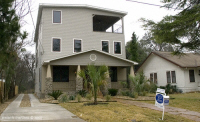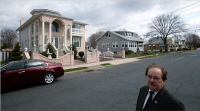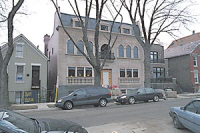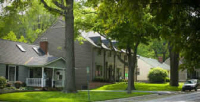We've all seen it happen - one day you drive by that nice airplane bungalow for sale down the street, only to see that it's gone - scraped down to the foundation. A few weeks later you notice that they've got a new foundation poured, and it's huge. A few weeks later, framing starts, and the house goes up quickly. What was once a nice, modest, story-and-a-half house has grown to three stories and has maxed out the lot. Then, it's finished, and it's like the mother ship has landed - three or four thousand square feet of house, no windows on the sides, a two-car (maybe three!) garage facing the street.
You've just been McMansioned . . . and there's nothing you can do about it, in most cities. In Kansas City.
Or is there? Residents in older neighborhoods in Kansas City are waking up to a reality that has already manifested itself in other cities across the nation. Homes that - in the eyes of some - have outlived their usefulness are surrendering to the bulldozer, only to reawaken as some kind of Frankenstein - mismatched, ungainly styles competing for attention on a footprint that, while within the letter of the code, has been pushed to the setback lines and to the maximum allowable height that the code allows.
It makes a certain sense, really - as the cost of fuel rises and commute times get longer and longer, more and more suburbanites and exurbanites are rediscovering the convenience of living closer to town. What's more, in Kansas City - as in other cities - there are many desirable neighborhoods filled with beautiful homes located quite near the downtown business core. Brookside, Armour Hills, Mission Hills, Prairie Village - we all know these areas and the many distinguished houses lining their streets.
Moving back into town is fine . . . except that these new residents want to have it all. They want to import their suburban models of living back into the urban core. What looks fine (well, at least tolerable) on five acres is going to look ridiculous stuffed onto urban lots that are often far less than one acre or even half an acre. Attached two- and three-car garages are the standard in the suburbs, while intown houses make do with a detached garage, a tandem drive-under garage, or often none at all. The front porch - a common feature of older homes - is relegated to a back deck, while the garage is the element that greets neighbors. Trees that have stood for almost a century have to be torn down to shoehorn these gargantuan houses onto their lots.
This phenomenon has already occurred in Prairie Village and Mission Hills - these Kansas neighborhoods hug the state line, so commuting to downtown is easy, and Johnson county schools are some of the best in the community. Many post-war ranches and Cape Cods have come down in the past few years and have been replaced with the modern versions of English country estates or ersatz Prairie-influenced houses. Some Brookside houses have already been demolished and replaced with newer houses, and the trend will only continue as more and more suburbanites "come home" to Kansas City.
Cities are often slow to respond to this veiled threat; planning and development committees are often staffed by people who have little or no background in city planning and design, and building codes address only the most basic requirements of building - respect the setbacks and make the building safe. What cities are slowly waking up to is that the very things that distinguish older neighborhoods - graceful, well-designed houses with mature landscaping and vegetation that make up a neighborhood versus simply a collection of houses - are the things that are the first to go. Many city governments see only the increased property tax revenue coming from these oversized developments; even other residents might welcome this kind of re-development, since it will automatically increase the value of their own homes.
What can those of us who live in older neighborhoods and value what they have to offer do about this? Get involved, for one thing. Think about the issue, tour some neighborhoods where it's already happening, go see what has happened in other cities - Dallas and Atlanta, for example - and decide if this is what you want the future of your city to be. No one wants to say "no" to new development - change and growth are natural for cities - but the greater answer is to ask that any new development respect its surroundings and fit in rather than stand out.
There is a proposed amendment to the Kansas City zoning ordinance that would create "overlay" districts for intown neighborhoods. If approved, this overlay concept would limit the size and height of new development; it would also limit other issues like garages. Each neighborhood would have to go through a process to obtain the permission to institute an overlay - this means getting the majority of the homeowners in the neighborhood to approve it. Design guidelines can be worked into the overlay if the neighborhood wishes it.
The Historic Kansas City Foundation is starting to think about this issue. Many remember HKCF president Jane Flynn and her tireless devotion to Kansas City's many historic neighborhoods. HKCF member Dona Boley has published several articles recently that carry on that tradition of preservation and concern for Kansas City's architecture. These articles provide a good summary and background about what's happening and what can be done about it.
The Kansas City Bungalow Club is equally concerned about the issue of McMansions and teardowns in our city. Our members appreciate historic architecture and the value it brings to Kansas City; many of our members are on intimate terms with historic houses - they live in them! They love the simplicity, grace and beauty of older homes, many of which cannot be duplicated today.



The illustration below shows the new house in relation to its neighbors.

Teardowns don't have to have only negative outcomes, nor are they the only alternative to building a new home. MARC - the Mid-America Research Council - has published a guide to renovating and modifying several postwar housing types in Kansas City's inner-ring suburbs. That book - "First Suburbs Coalition Idea Book" - is available here. Author and architect Sarah Susanka has written two very well received books about socially-responsible living and building, "The Not-so-big House" and "Not-so-big Remodeling". These books are available at your local bookshop or online from stores such as Amazon or Barnes and Noble.
If a house is so far gone that it's simply not worthwhile to try to save it and a teardown is necessary, please think about going green and recycling the house's components through Habitat ReStore. Kansas City has its own chapter of ReStore. Any donations you make are tax-deductible and you'll have the further satisfaction of reducing the amount of stuff that goes into a landfill.
Finally, know that teardowns can happen anywhere in the city. If you find that your neighborhood is under attack from ill-considered development, be proactive! Join your neighborhood's architectural review board, if they have one, or think about starting one up. That way you can at least begin to guide the growth that occurs, rather than being powerless to modify it.